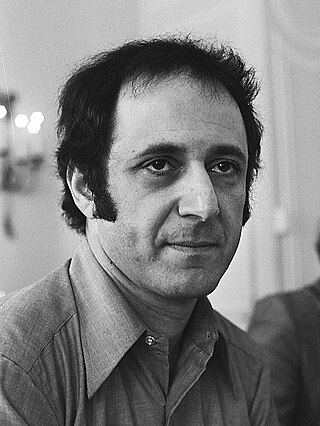The topic of this article may not meet Wikipedia's notability guideline for music .(October 2017) |
Alex Dea is an American composer. [1]
The topic of this article may not meet Wikipedia's notability guideline for music .(October 2017) |
Alex Dea is an American composer. [1]
Alex Dea was trained in Western classical music and received a Ph.D. in Ethnomusicology from Wesleyan University, with a specialty in Javanese gamelan music. He was a performer in La Monte Young's experimental music group Theatre of Eternal Music. [2] Other mentors include prominent avant-garde composers Terry Riley and Robert Ashley. He has also studied the musics of Africa and Japan – and studied raga with the Hindustani master Pandit Pran Nath. Dea recently works in the gamelan form. One of his gamelan compositions, In Pelog , is the result of his collaboration with Prof. Dr. Sumarsan, an Indonesian teaching at Wesleyan University. [3]

Stephen Michael Reich is an American composer best known as a pioneer of minimal music in the mid to late 1960s. Reich's work is marked by its use of repetitive figures, slow harmonic rhythm, and canons. Reich describes this concept in his essay, "Music as a Gradual Process", by stating, "I am interested in perceptible processes. I want to be able to hear the process happening throughout the sounding music." For example, his early works experiment with phase shifting, in which one or more repeated phrases plays slower or faster than the others, causing it to go "out of phase." This creates new musical patterns in a perceptible flow.

Terrence Mitchell "Terry" Riley is an American composer and performing musician best known as a pioneer of the minimalist school of composition. Influenced by jazz and Indian classical music, his work became notable for its innovative use of repetition, tape music techniques, improvisation, and delay systems. His best known works are the 1964 composition In C and the 1969 album A Rainbow in Curved Air, both considered landmarks of minimalism and important influences on experimental music, rock, and contemporary electronic music. Subsequent works such as Shri Camel (1980) explored just intonation.

La Monte Thornton Young is an American composer, musician, and performance artist recognized as one of the first American minimalist composers and a central figure in Fluxus and post-war avant-garde music. He is best known for his exploration of sustained tones, beginning with his 1958 composition Trio for Strings. His compositions have called into question the nature and definition of music, most prominently in the text scores of his Compositions 1960. While few of his recordings remain in print, his work has inspired prominent musicians across various genres, including avant-garde, rock, and ambient music.

In C is a musical piece composed by Terry Riley in 1964. It consists of series of 53 short melodic fragments that can be repeated at the discretion of the musicians. It is often cited as the first minimalist composition to make a significant impact on the public consciousness and inspire a new movement. The number of performers is unspecified. Riley suggests "a group of about 35 is desired if possible but smaller or larger groups will work".

In music, tape loops are loops of magnetic tape used to create repetitive, rhythmic musical patterns or dense layers of sound when played on a tape recorder. Originating in the 1940s with the work of Pierre Schaeffer, they were used among contemporary composers of 1950s and 1960s, such as Éliane Radigue, Steve Reich, Terry Riley, and Karlheinz Stockhausen, who used them to create phase patterns, rhythms, textures, and timbres. Popular music authors of 1960s and 1970s, particularly in psychedelic, progressive and ambient genres, used tape loops to accompany their music with innovative sound effects. In the 1980s, analog audio and tape loops with it gave way to digital audio and application of computers to generate and process sound.
Violin Phase is a musical work written by minimalist composer Steve Reich in October 1967.
Minimal music is a form of art music or other compositional practice that employs limited or minimal musical materials. Prominent features of minimalist music include repetitive patterns or pulses, steady drones, consonant harmony, and reiteration of musical phrases or smaller units. It may include features such as phase shifting, resulting in what is termed phase music, or process techniques that follow strict rules, usually described as process music. The approach is marked by a non-narrative, non-teleological, and non-representational approach, and calls attention to the activity of listening by focusing on the internal processes of the music.
Drone music, drone-based music, or simply drone, is a minimalist genre of music that emphasizes the use of sustained sounds, notes, or tone clusters called drones. It is typically characterized by lengthy compositions featuring relatively slight harmonic variations. La Monte Young, one of its 1960s originators, defined it in 2000 as "the sustained tone branch of minimalism." Music containing drones can be found in many regional traditions across Asia, Australia, and Europe, but the genre label is generally reserved for music originating with the Western classical tradition. Elements of drone music have been incorporated in diverse genres such as rock, ambient, and electronic music.

Six Pianos is a minimalist piece for six pianos by the American composer Steve Reich. It was completed in March 1973. He also composed a variation for six marimbas, called Six Marimbas, in 1986. The world première performance of Six Pianos was in May 1973 at the John Weber Gallery in New York City. The European première took place in January the next year in Stuttgart, Germany.
Jon Gibson was an American flutist, saxophonist, composer and visual artist, known as one of the founding members of the Philip Glass Ensemble. He was a key player on several seminal minimalist music compositions. He was born in Los Angeles to Charles and Muriel Gibson, both educators, and grew up in El Monte, a suburb.
Systems music is music with sound continua which evolve gradually, often over very long periods of time. Historically, the American minimalists Steve Reich, La Monte Young and Philip Glass are considered the principal proponents of this compositional approach. Works by this group of composers are often characterized by features such as stasis or repetitiveness.
Scott Richard Johnson was an American composer known for his pioneering use of recorded speech as musical melody, and his distinctive crossing of American vernacular and art music traditions, making extensive use of electric guitar in concert works, and adapting popular music structures for art music genres such as the string quartet. He was the recipient of a 2006 Guggenheim fellowship, and a 2015 American Academy of Arts and Letters Award.
David Russell Borden is an American composer and keyboard player of minimalist music.
Arthur "Art" Bixler Murphy was a classical and jazz musician, pianist and composer. He was born in Princeton, New Jersey. He grew up in Oberlin, OH, where his father was a member of the Oberlin College faculty.

Betty Freeman was an American philanthropist and photographer.

The dream chord is a chord that is used prominently in the works of La Monte Young. It is made up of the pitches G-C-C♯-D. The chord is prominently featured in Young's compositions for Brass (1957), Trio for Strings (1958), and The Four Dreams of China (1962).

The Magic Chord is a chord and installation (1984) created by La Monte Young, consisting of the pitches E, F, A, B♭, D, E, G, and A, in ascending order and used in works including his The Well-Tuned Piano and Chronos Kristalla (1990). The latter was performed by the Kronos Quartet and features all notes of the magic chord as harmonics on open strings. The quartet has been described as, "offer[ing] perhaps the ultimate challenge in performing in a just environment".
Reed Phase, also called Three Reeds, is an early work by the American minimalist composer Steve Reich. It was written originally in 1966 for soprano saxophone and two soprano saxophones recorded on magnetic tape, titled at that time Saxophone Phase, and was later published in two versions: one for any reed instrument and tape, the other for three reed instruments of exactly the same kind. It was Reich's first attempt at applying his "phasing" technique, which he had previously used in the tape pieces It's Gonna Rain (1965) and Come Out (1966), to live performance.
The Compositions 1960 are a set of text-based musical pieces written in 1960 by composer La Monte Young. Building on the work of John Cage, these pieces are unique in their emphasis on performance art and unconventional actions, such as releasing a butterfly into the room (#5), building a fire in front of the audience (#2), or pushing a piano into a wall. These compositions have been described as calling into question the definition of music.